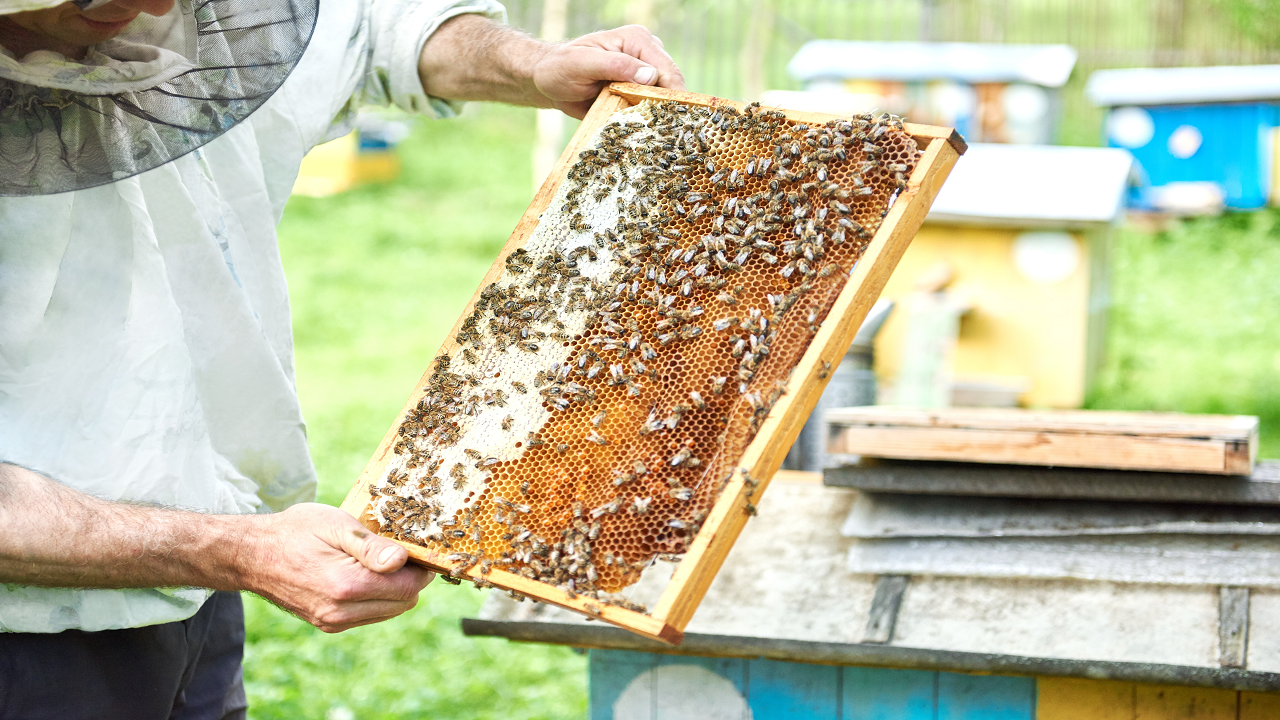
Bees represent among the numerous insect species globally capable of creating something advantageous for humanity. They provide us with honey, a crucial nutritional resource. Throughout history, honey has been utilized for the treatment of various ailments and is recognized as an antioxidant, underscoring the significance of beekeeping.
Meaning of Apiculture/Beekeeping
The term 'apiculture' originates from the Latin term 'apis,' which translates to bee. Therefore, apiculture, or the practice of beekeeping, involves the nurturing and supervision of honey bees with the aim of generating honey and wax. This approach entails the controlled breeding of bees within apiaries, designated spaces capable of accommodating multiple beehives. Typically, these apiaries are situated in regions abundant with bee-friendly environments, such as areas abundant in flowering plants.
Products Obtained From Beekeeping
Apiculture, or beekeeping as it is commonly called, encompasses the administration of bee colonies to acquire a range of products esteemed for their economic, dietary, and therapeutic significance. The following are key yields derived from the practice of beekeeping:
1. Honey: Honey stands as perhaps the most renowned outcome of beekeeping. Bees gather nectar from blossoms, transform it into honey via enzymatic processes, and store it within hexagonal cells of the honeycomb. Beekeepers retrieve honey from these cells and refine it for human consumption. Honey is employed as an organic sweetener, finds use in culinary endeavours, and holds potential advantages for well-being.
2. Beeswax: Beeswax, a natural wax crafted by bees to shape their honeycomb cells, emerges as a valuable byproduct. Beekeepers can amass and purify beeswax for diverse applications, which encompass crafting candles, producing cosmetics, soaps, and other skincare items.
2. Royal Jelly: Royal jelly, a secretion produced by worker bees and used to nourish larvae, enabling their transformation into queen bees, showcases a high nutrient content and is thought to offer potential health gains. Royal jelly serves as a dietary supplement and is occasionally integrated into cosmetic formulations.
3. Propolis: Propolis, a resinous substance harvested by bees from sources such as tree buds and sap, serves as a protective sealant for beehives. Possessing inherent antimicrobial and antioxidant qualities, propolis finds utility in certain health and wellness products.
4. Bee Pollen: Bee pollen is a blend of pollen harvested by bees from different blossoms. Rich in proteins, vitamins, minerals, and additional nutrients, bee pollen is sometimes ingested as a dietary supplement because of its possible nutritional advantages.
How To Start Honey Bee Farming In India?
Beekeeping is on the rise in India, with potential for both independent commercial honey production and integration with agriculture to boost crop yields and generate extra income through honey sales. Comprehensive guidance is available for starting honey production in India through a solid grasp of apiculture methods.
The historical legacy of honey bee rearing, known as Apiculture or "madhumakhi palan" in Hindi, is deeply rooted. Honeybee farming has influenced literature, philosophy, art, culture, and architecture, making bees some of the most studied insects globally. Their dedicated work ethic and teamwork inspire admiration, making beekeeping a widely practised and attractive form of agriculture and lifestyle.
Things To Know Before Starting Honey Bee Farming In India
Apiculture presents its own array of challenges, encompassing various issues and potential remedies pertaining to beekeeping in India. These challenges and potential solutions are outlined below.
1. Beekeeping Expertise
Gaining thorough knowledge about beekeeping is crucial. Farmers need to understand the beekeeping process, bee biology, human-bee interactions, sting management, and related aspects. Local beekeeping authorities offer valuable training, including from entities like the National Bee Board and Central Bee Research Training Institute under the Agriculture Department. Working with local farmers before starting beekeeping is advised, providing practical experience and current insights into apiculture.
2. Strategizing for Beekeeping in India
Following the accumulation of sufficient experience, the subsequent step involves crafting a meticulous plan for the apiculture endeavor. This necessitates making well-informed decisions regarding the location, bee species selection, equipment to be utilized, and notably, the marketing strategy.

3. Understanding the Flora and Ecology of the Locale
A thorough understanding of the local ecological dynamics and flora proves invaluable in guiding the farmer's choices. This knowledge aids in determining the most suitable bee species to rear for honey production within the Indian context.
Traditional Methods of Beekeeping in India
The beekeeping business in India has historical roots, resulting in various methods of beekeeping.
Clay Pots:
In some regions of southern India, bees are raised within clay pots. These pots, with air holes and coated with beeswax, are strategically placed in gardens to attract swarms. Once a colony is established, an inverted pot is added. When the rainy season arrives, the pots are overturned, and honey is collected.
Tree Trunks:
At altitudes above 1800 meters sea level, tree trunks or hollow wooden logs serve as hives for beekeeping.
Wall Hives:
Common in northern states like Jammu and Kashmir, as well as parts of the Himalayas, wall hives are essentially empty spaces integrated into the eastern side of houses.
Modern Hives:
Contemporary beehives are rectangular wooden boxes that can be easily relocated. They consist of seven primary components:
-
Stand: A supportive base with four legs.
-
Floor Board: A tray-like drawer raised on all sides and featuring an alighting board in front for easy access.
-
Brood Box: A rectangular frame with scooped shelves along its length for bees to construct comb.
-
Hive Frame: Wooden frames with top and bottom bars, supporting comb foundation with wires.
-
Queen Excluder: A wired frame allowing worker bees to pass while preventing the queen from accessing the super chamber.
-
Super Chamber: A chamber designed for honey storage, akin to the brood box but shorter.
-
Cover: Dual covers – inner and outer – protect the hive. The inner cover maintains humidity and temperature, while the outer cover acts as a roof, shielding from rain and sunlight.
These diverse beekeeping methods reflect the rich tradition and innovation within Indian apiculture.
Tips For Honey Harvesting
Bees' continuous hard work is vital for food production, especially through pollination of plants that sustain various creatures. From coffee to chocolate, many everyday items are possible due to bees' contributions. Additionally, bees produce honey and wax, and beekeepers in the Northwestern region are gearing up for honey harvesting. Whether you're new to beekeeping or experienced, learning about honey harvesting is valuable, and we've assembled useful tips for the task.
Here are some tips for honey harvesting:
-
Timing: Choose the right time to harvest honey, usually after the bees have capped the honey cells with wax. This indicates that the moisture content is low and the honey is ripe.
-
Protective Gear: Wear appropriate protective clothing, including a beekeeper suit, gloves, and a veil, to avoid bee stings during the harvesting process.
-
Smoking: Use a bee smoker to calm the bees before opening the hive. A puff of smoke disrupts their communication and makes them less aggressive.
-
Bee Removal: Gently brush or blow the bees off the frames using a bee brush or a blower specifically designed for beekeeping.
-
Uncapping: Use a sharp uncapping knife or an uncapping fork to remove the wax cappings from the honeycomb cells. This exposes the honey for extraction.
-
Extraction: Place the uncapped frames in a honey extractor, which uses centrifugal force to spin the honey out of the cells. There are both manual and motorized extractors available.
-
Straining: After extraction, strain the honey to remove any remaining wax, bee parts, or debris. Use a fine mesh strainer or cheesecloth.
-
Settling: Allow the strained honey to settle for a day or two to let any air bubbles rise to the top.
-
Bottling: Carefully pour or siphon the clear honey into clean and dry containers. Use food-grade plastic or glass bottles with tight-sealing lids.
-
Labeling: Label each container with the harvest date and any relevant information about the honey, such as its floral source or location.
Remember, honey harvesting requires careful consideration for the well-being of the bees and the quality of the honey. It's essential to follow proper beekeeping practices and respect the bees' efforts throughout the process.

















